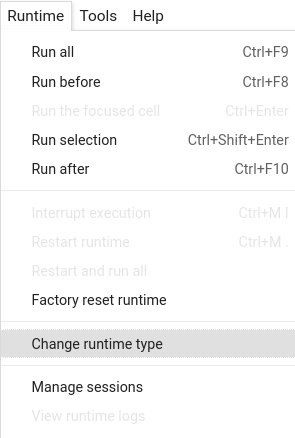Utilizing existing FAQs for Question Answering
While extractive Question Answering works on pure texts and is therefore more generalizable, there’s also a common alternative that utilizes existing FAQ data.
Pros:
- Very fast at inference time
- Utilize existing FAQ data
- Quite good control over answers
Cons:
- Generalizability: We can only answer questions that are similar to existing ones in FAQ
In some use cases, a combination of extractive QA and FAQ-style can also be an interesting option.
Prepare environment
Colab: Enable the GPU runtime
Make sure you enable the GPU runtime to experience decent speed in this tutorial. Runtime -> Change Runtime type -> Hardware accelerator -> GPU

You can double check whether the GPU runtime is enabled with the following command:
%%bash
nvidia-smi
To start, install the latest release of Haystack with pip:
%%bash
pip install --upgrade pip
pip install git+https://github.com/deepset-ai/haystack.git#egg=farm-haystack[colab]
Logging
We configure how logging messages should be displayed and which log level should be used before importing Haystack. Example log message: INFO - haystack.utils.preprocessing - Converting data/tutorial1/218_Olenna_Tyrell.txt Default log level in basicConfig is WARNING so the explicit parameter is not necessary but can be changed easily:
import logging
logging.basicConfig(format="%(levelname)s - %(name)s - %(message)s", level=logging.WARNING)
logging.getLogger("haystack").setLevel(logging.INFO)
Start an Elasticsearch server
You can start Elasticsearch on your local machine instance using Docker. If Docker is not readily available in your environment (eg., in Colab notebooks), then you can manually download and execute Elasticsearch from source.
# Recommended: Start Elasticsearch using Docker via the Haystack utility function
from haystack.utils import launch_es
launch_es()
Start an Elasticsearch server in Colab
If Docker is not readily available in your environment (e.g. in Colab notebooks), then you can manually download and execute Elasticsearch from source.
%%bash
wget https://artifacts.elastic.co/downloads/elasticsearch/elasticsearch-7.9.2-linux-x86_64.tar.gz -q
tar -xzf elasticsearch-7.9.2-linux-x86_64.tar.gz
chown -R daemon:daemon elasticsearch-7.9.2
sudo -u daemon -- elasticsearch-7.9.2/bin/elasticsearch -d
%%bash --bg
sudo -u daemon -- elasticsearch-7.9.2/bin/elasticsearch
Init the DocumentStore
In contrast to Tutorial 1 (Build your first QA system), we:
- specify the name of our
text_fieldin Elasticsearch that we want to return as an answer - specify the name of our
embedding_fieldin Elasticsearch where we’ll store the embedding of our question and that is used later for calculating our similarity to the incoming user question - set
excluded_meta_data=["question_emb"]so that we don’t return the huge embedding vectors in our search results
import os
import time
from haystack.document_stores import ElasticsearchDocumentStore
# Wait 30 seconds only to be sure Elasticsearch is ready before continuing
time.sleep(30)
# Get the host where Elasticsearch is running, default to localhost
host = os.environ.get("ELASTICSEARCH_HOST", "localhost")
document_store = ElasticsearchDocumentStore(
host=host,
username="",
password="",
index="document",
embedding_field="question_emb",
embedding_dim=384,
excluded_meta_data=["question_emb"],
similarity="cosine",
)
Create a Retriever using embeddings
Instead of retrieving via Elasticsearch’s plain BM25, we want to use vector similarity of the questions (user question vs. FAQ ones).
We can use the EmbeddingRetriever for this purpose and specify a model that we use for the embeddings.
from haystack.nodes import EmbeddingRetriever
retriever = EmbeddingRetriever(
document_store=document_store,
embedding_model="sentence-transformers/all-MiniLM-L6-v2",
use_gpu=True,
scale_score=False,
)
Prepare & Index FAQ data
We create a pandas dataframe containing some FAQ data (i.e curated pairs of question + answer) and index those in elasticsearch. Here: We download some question-answer pairs related to COVID-19
import pandas as pd
from haystack.utils import fetch_archive_from_http
# Download
doc_dir = "data/tutorial4"
s3_url = "https://s3.eu-central-1.amazonaws.com/deepset.ai-farm-qa/datasets/documents/small_faq_covid.csv.zip"
fetch_archive_from_http(url=s3_url, output_dir=doc_dir)
# Get dataframe with columns "question", "answer" and some custom metadata
df = pd.read_csv(f"{doc_dir}/small_faq_covid.csv")
# Minimal cleaning
df.fillna(value="", inplace=True)
df["question"] = df["question"].apply(lambda x: x.strip())
print(df.head())
# Get embeddings for our questions from the FAQs
questions = list(df["question"].values)
df["question_emb"] = retriever.embed_queries(queries=questions).tolist()
df = df.rename(columns={"question": "content"})
# Convert Dataframe to list of dicts and index them in our DocumentStore
docs_to_index = df.to_dict(orient="records")
document_store.write_documents(docs_to_index)
Ask questions
Initialize a Pipeline (this time without a reader) and ask questions
from haystack.pipelines import FAQPipeline
pipe = FAQPipeline(retriever=retriever)
from haystack.utils import print_answers
prediction = pipe.run(query="How is the virus spreading?", params={"Retriever": {"top_k": 10}})
print_answers(prediction, details="medium")
About us
This Haystack notebook was made with love by deepset in Berlin, Germany
We bring NLP to the industry via open source!
Our focus: Industry specific language models & large scale QA systems.
Some of our other work:
Get in touch: Twitter | LinkedIn | Discord | GitHub Discussions | Website
By the way: we’re hiring!